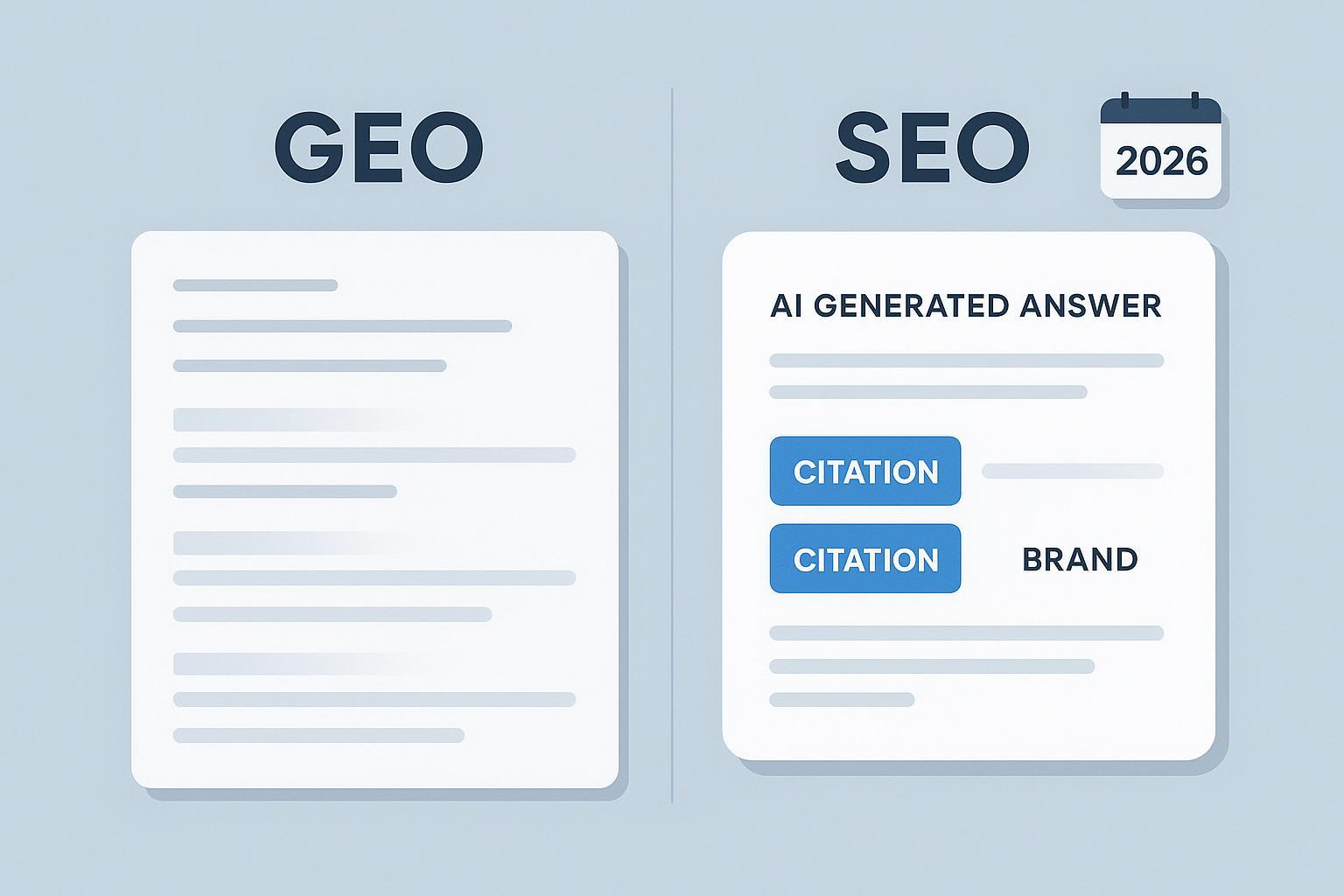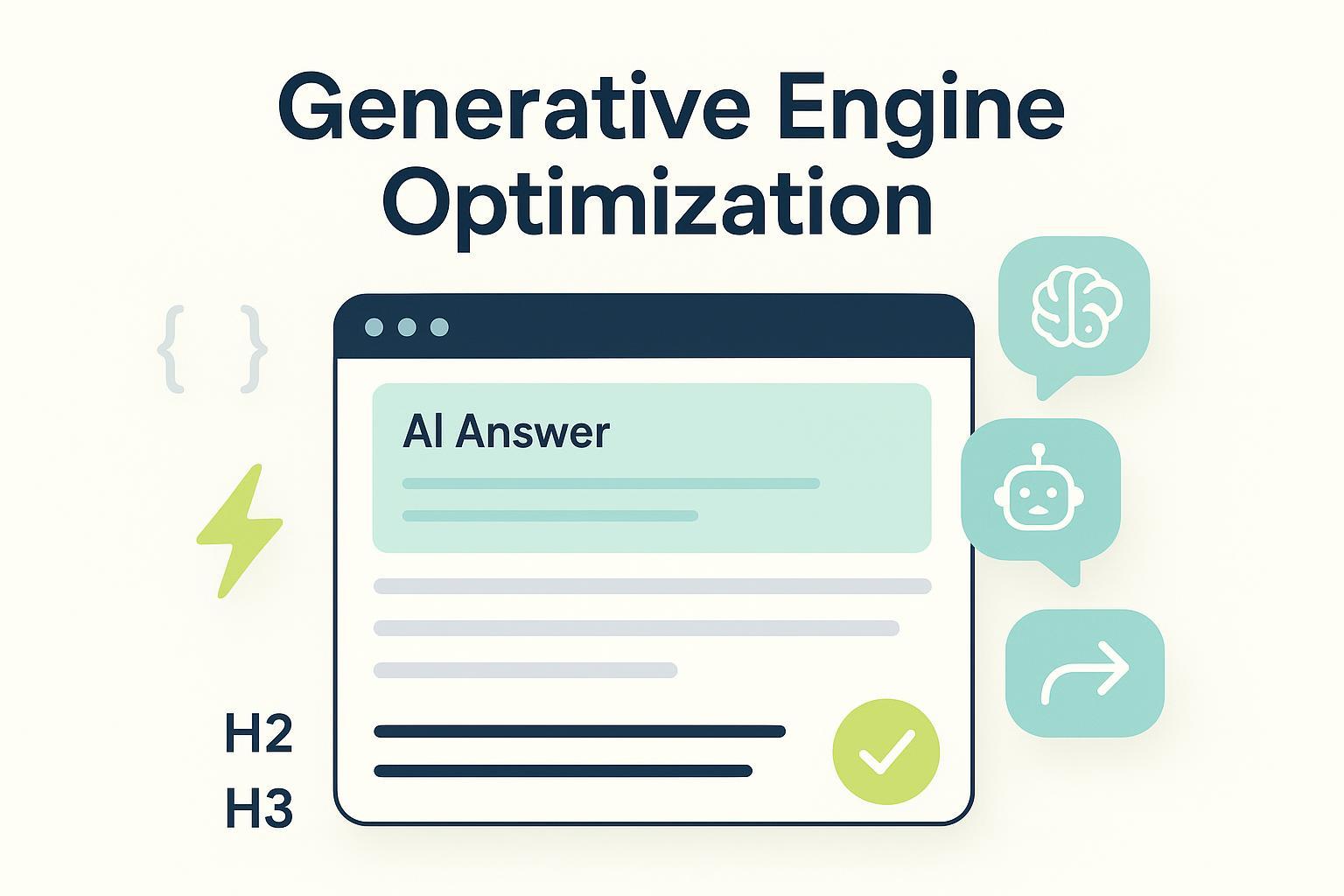Why GEO Matters More Than SEO in 2026: Latest AI Search Trends
Discover why GEO leads over SEO in 2026. Get expert insights on AI answers, citations, and top measurement strategies. Read now to optimize your visibility.


The front page of discovery has shifted. More of your buyers now form opinions inside AI-generated answers, where inclusion and citation carry weight even if no click happens. That’s why GEO—Generative Engine Optimization—moves to the top of the roadmap in 2026 for information-heavy journeys, while SEO keeps its essential role for navigational and transactional capture.
GEO vs. SEO—what actually changes
GEO optimizes your content and entities to be included and cited inside AI-generated responses across engines like Google’s AI Overviews/AI Mode, ChatGPT, and Perplexity. SEO optimizes for rankings on classic SERPs to earn clicks. Multiple 2025 explainers outline this distinction clearly; for example, Search Engine Land’s comparison of SEO vs. GEO—what’s different, what’s the same (2025) and Strapi’s guide on Generative Engine Optimization vs. traditional SEO (2025).
Practically, GEO emphasizes entity clarity, corroborated claims, author credentials, structured data, and passage-level prose that’s easy for LLMs to quote—patterns noted in practitioner frameworks like Profound’s 10-step GEO guide (2025). If you want a deeper primer on how “AI visibility” differs from classic SEO traffic, see our internal overview: AI visibility explained for brands.
Where answers happen in 2026
Updated on 2025-11-18
Google’s AI features increasingly summarize and reason before listing links. For site owners, Google’s documentation “AI features and your website” (updated Nov 2025) explains how AI Overviews and AI Mode present synthesized answers. Trade coverage notes that citations appear more consistently but not universally; see Search Engine Land’s guide to AI Mode (Oct 2025).
OpenAI’s ChatGPT continues to add research-oriented features. In February 2025, OpenAI introduced Deep Research, stating that “Every output is fully documented, with clear citations”. Interface specifics can vary by mode, but the direction is consistent: answers with visible sources.
Perplexity, designed as an answer engine, foregrounds multi-source citations. Its Deep Research mode highlights extensive citation lists (Feb 2025). For platform-by-platform differences in sourcing and citation norms, this internal comparison offers a useful overview: ChatGPT vs. Perplexity vs. Gemini vs. Bing—AI search monitoring.
Evolving facts note: UI and citation schemas are actively changing across all engines. Treat specifics as “as of late 2025” and plan refreshes.
When GEO outranks SEO in your roadmap
In 2026, GEO should lead whenever the query’s intent is settled inside the AI interface. Think of early-stage research like “best B2B payment platforms for mid-market,” a space where a synthesized answer can frame the shortlist. Inclusion and favorable citation there shape awareness and consideration long before a click. Conversely, SEO remains the priority where users already know where they’re headed—navigational queries (“Salesforce login”) and high-intent transactional searches (“buy noise-canceling headphones”) still rely on SERP rankings and product pages.
Practical prioritization signals:
- Informational queries that trigger AI summaries or answer cards consistently.
- Categories with complex comparisons, where buyers want distilled guidance.
- Markets where branded expert commentary and datasets can be cited to confer authority.
If you’re asking, “Will this reduce clicks?”—for some informational journeys, yes. But the point is not to fight the interface; it’s to win visibility and trust within it.
The 2026 GEO measurement stack
You can’t manage what you don’t measure. The emerging consensus is to track citation-centric visibility alongside classic SEO metrics. Practitioner proposals include KPI sets such as Semantic Density, Vector Index Presence, and Retrieval Confidence discussed in Search Engine Land’s generative AI search KPIs (June 2025) and operational frameworks like Profound’s GEO methodology (2025). These KPI taxonomies are emergent rather than standardized; use them directionally and document your own definitions in reporting.
A tool-agnostic workflow that teams can implement now:
- Instrument AI bot traffic (e.g., GPTBot and other crawlers) and tag content areas in your analytics.
- Build a prompt/query library across your priority topics. Sample answers monthly across Google AI Overviews/AI Mode, ChatGPT (Deep Research/Atlas), and Perplexity. Log the query, platform, timestamp, cited URLs, attribution clarity, position in the answer, sentiment (positive/neutral/negative), and competing sources.
- Benchmark citation share and answer presence against named competitors. Identify overlap and missing angles; adjust content accordingly.
- Report monthly in Q1 2026, then quarterly. Refresh immediately after major engine updates (Gemini, GPT-4o/5, Claude releases). Use annotations to tie shifts to known product changes.
A neutral example workflow (allowed zone)
Here’s a practical micro-example of how teams log AI citations and sentiment across engines. Using Geneo, you can configure cross-engine monitoring to record which of your pages get cited inside Google AI Overviews/AI Mode, ChatGPT, and Perplexity answers, and track sentiment on those mentions over time. Disclosure: Geneo is our product.
The playbook: entity-first content that AI can quote
To earn inclusion, think like an answer engine. Create assets that are easy to retrieve, verify, and cite.
- Clarify entities: define your brand, people, products, and key concepts in ways machines can disambiguate. Link out to corroborating sources where appropriate.
- Add structured data: use schema types (Organization, Product, Person, Article, FAQ) to attach attributes and relationships.
- Make claims verifiable: cite primary sources for statistics; include year, sample, and scope near the claim.
- Establish authorship: pair content with expert bios and credentials that engines can cross-check.
- Write quote-ready passages: short, precise sections that summarize a claim or comparison cleanly.
- Expose datasets and methodologies: publish downloadable or documented data so engines “see” your original work.
Terminology can be foggy in this space. If you need a quick glossary for GEO and adjacent terms (AEO, GSVO, and others), see our guide to new AI search acronyms.
Governance, refresh cadence, and attribution modeling
Treat GEO as an ongoing program, not a one-off campaign. Maintain an update log for platform behavior sections—UI and citation changes can alter your outcomes. A practical cadence: monthly audits for the first quarter after rollout, then quarterly, with ad hoc checks after major model releases.
Attribution will remain messy for zero-click influence. Build a proxy stack: brand recall surveys on key categories, assisted-conversion modeling that credits answer inclusion, and qualitative feedback from sales and customer success. Where appropriate, test “follow-up” prompts that lead users to deeper resources—without trying to force clicks unnaturally.
What to do next (with a small agency note)
- Rebalance your 2026 roadmap: let GEO lead for informational queries settled in AI answers; keep SEO strong for navigational and transactional capture.
- Stand up a measurement stack for AI citations, answer presence, and sentiment. Keep a clear audit trail and refresh cadence.
- Build entity-first, citation-ready assets with structured data, expert attribution, and verifiable claims.
For agencies packaging AI visibility services, consider a pragmatic monitoring layer to prove outcomes to clients. If you work with multiple brands, this overview may help: AI Visibility Tool for Agencies.
Mini change-log
- 2025-11-18: Initial publication using late-2025 documentation for Google AI Mode/Overviews, OpenAI Deep Research, and Perplexity Deep Research. Platform UI specifics are marked as evolving; monthly refresh recommended in Q1 2026.





